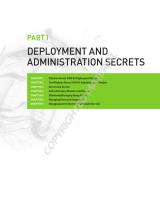
4 Using Your NAS System.........................................................................................23
Creating A Server Message Block Share.............................................................................................23
Modifying Message Block Shares....................................................................................................... 23
NFS Share............................................................................................................................................ 24
Windows 2003 Domain Controller As Identity Mapping Source......................................................24
Windows 2008 Domain Controller As Identity Mapping Source......................................................24
Windows 2012 Domain Controller As Identity Mapping Source.......................................................25
User Name Mapping Server As Identity Mapping Source..................................................................25
Active Directory Lightweight Directory Services As Identity Mapping Source.................................26
Configuring AD LDS For Services For NFS......................................................................................... 26
Installing The AD LDS Server Role...................................................................................................... 27
Creating A New AD LDS Instance.......................................................................................................27
Extending The AD LDS Schema To Support NFS User Mapping.......................................................28
Setting A Default Instance Name For AD LDS Instances...................................................................29
Updating The Active Directory Schema.............................................................................................29
Adding User And Group Account Maps From A UNIX-Based System To A Windows-Based
System................................................................................................................................................. 30
Connecting To The Distinguished Name Or Naming Context.........................................................30
Adding User Account Maps.................................................................................................................31
Adding Group Account Maps..............................................................................................................31
Authorizing Appropriate Access To The ADS LDS Namespace Object............................................ 32
Configuring The Mapping Source...................................................................................................... 32
Debug Notes For NFS Account Mapping Problems.......................................................................... 33
Restarting The Server For NFS............................................................................................................ 33
Creating The NFS Share......................................................................................................................33
Creating Quotas And File Screens Using File Server Resource Manager......................................... 34
Creating A New Volume..................................................................................................................... 34
Managing A Volume............................................................................................................................34
Extending A Volume............................................................................................................................35
Extending A Basic Volume Using The Windows Interface...........................................................35
Extending A Basic Volume Using CLI........................................................................................... 35
Shrinking A Volume.............................................................................................................................35
Additional Considerations When Shrinking A Volume.................................................................36
Deleting A Volume.............................................................................................................................. 36
Additional Information When Deleting A Volume....................................................................... 36
Data Deduplication............................................................................................................................. 36
Enabling And Configuring Shadow Copies Of Shared Folders......................................................... 37
Performing Backup Of Your Server Using Windows Server Backup Feature................................... 38
Choosing Volumes To Backup...........................................................................................................38
Choosing A Storage Location.............................................................................................................39
NIC Teaming....................................................................................................................................... 39




















